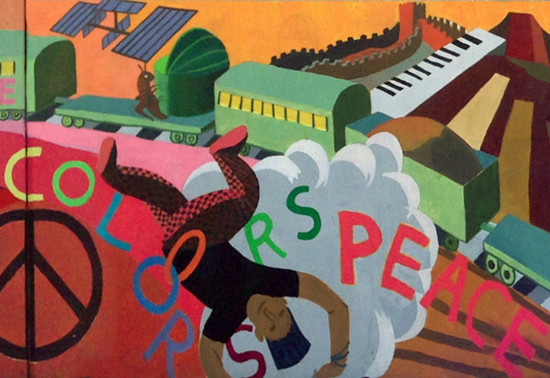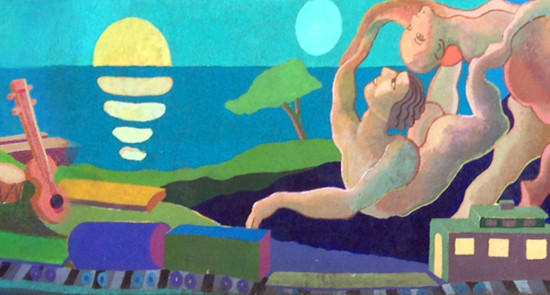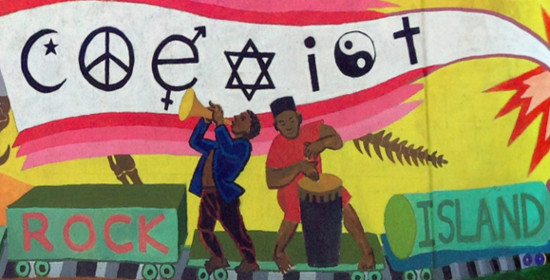
Cadence of Diversity is a joyful mural - rich with expressions of many cultures that are balanced with an underlying theme of connectedness.
The 100-foot-long mural is painted on a concrete wall just south of Seventh Avenue on 38th Street in Rock Island. Working with more than 50 Augustana students, Peter Xiao - a professor of art at the college - led the mural's development and execution throughout much of 2009, completing the work in the spring of 2010.
The mural depicts a wide range of nationalities and cultures through its figures, symbols, and landmarks, drawn together by the word "coexist" at its center. The main figures differ in age, race, and sex, yet they are primarily engaged in shared experience: music. Repeated forms tie together other elements of the mural; the same patterns in the Great Wall of China, for example, are unexpectedly found on the legs of a spinning break dancer.
The figures and symbols are further connected by a train, the Rock Island Line, that weaves its way through this festive, rolling landscape. The railroad cars and ties along the tracks create a rhythm that visually represents a musical tempo and cadence.
The Rock Island Line was a company that operated an extensive network of railroads across the central states - from Chicago to Omaha, from Minneapolis to Texas. Originally founded in Rock Island in the 1850s, the railroad's name serves as a metaphor for the community in the mural.

Also running the length of the mural are the lyrics to the song "The Rock Island Line." John Lomax first recorded the song in 1934 when it was sung by inmates in an Arkansas prison. Since then, it has been recorded by a great range of performers - from blues singer Lead Belly to country singer Johnny Cash, from calypso singer Harry Belafonte to each of the former Beatles. (The song and railroad were also elements of Augustana Assistant Professor Jacob Bancks' Rock Island Line, which the Quad City Symphony debuted in March.) This variety of musical styles is reflected in the folk, jazz, and classical instruments and musicians represented in the mural.
The background is painted in the sequence of colors of the visible spectrum, which can be seen as symbolizing the breadth of cultures brought together in our community and though the college. The Eiffel Tower, the Coliseum, and the Great Wall of China represent different cultures and also Augustana's overseas programs. Other objects, such as the dinosaur fossils in the college's Fryxell Geology Museum, relate specifically to Augustana's campus.

The word "coexist" is formed in part by three symbols that stand for Islam, Judaism, and Christianity. Appropriated from a popular logo created by Piotr Mlodozeniec for an exhibition in Jerusalem to promote religious tolerance, the grouping gives the mural a visual focus; its familiarity draws our attention. Yet that familiarity might prevent a causal viewer from looking more closely at the rest of the work, which takes far more time to fully appreciate.
The mural poetically finds rhythms and patterns in diverse activities and distant places. It reaches for universal themes but is rooted in this area through its use of symbols from the college, the community, and our railroad heritage. It is also Midwestern in its stylistic abstraction and rolling forms, similar to paintings by Grant Wood and the other regionalist artists.
The musicians and dancers that populate the mural don't directly interact with the symbols or passing train, yet the locomotive's winding path links them. Each is connected - even if unknowingly - through the spirit of the song they are playing.
Bruce Walters is a professor of art at Western Illinois University.
This is part of an occasional series on the history of public art in the Quad Cities. If there's a piece of public art that you'd like to learn more about, e-mail the location and a brief description to BD-Walters@wiu.edu.









